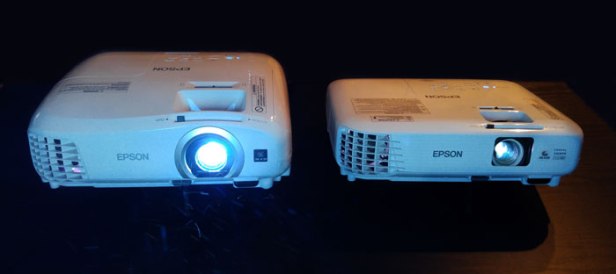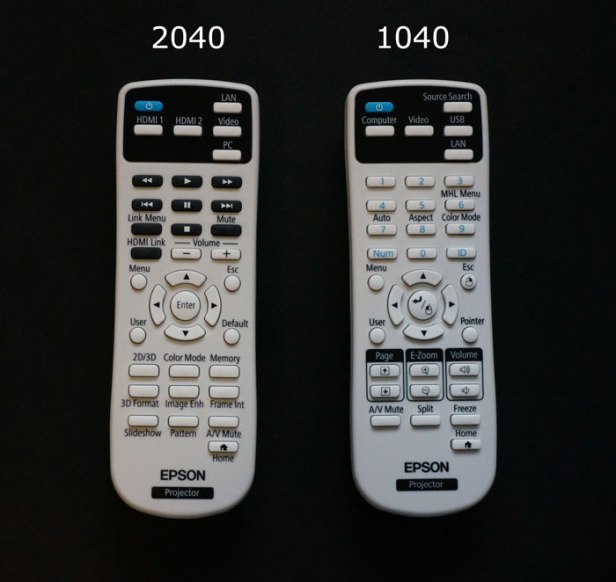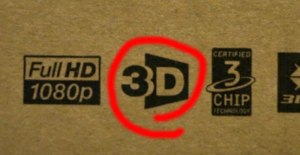
Epson Home Cinema 2040 1080p 3D 3LCD Home Theater Projector
Epson Home Cinema 1040 1080p, 2x HDMI (1 MHL) Home Theater Projector
★★★★☆
I had the opportunity to test out both the Epson Home Cinema 2040 and 1040 recently, and here are my thoughts comparing the two.
Both have a MSRP (USD) of $799 (with a varying street price not too far from one another), both are considered Home Cinema projectors by Epson, and both have HD resolution. Out of those three statements, however, I disagree with the second.
BOTH ARE HOME CINEMA PROJECTORS?
I have managed, tested and installed both Home Cinema and Multimedia projectors. In general, multimedia projectors tend to be used in conference rooms at business for giving presentations, whereas home theater or cinema projectors are for watching movies and playing video games. There is some gray area as to what makes one a multimedia and another a home cinema, but a few factors lean toward a specific type. Technically, you can use either for both purposes, but it’s best to aim for the areas that best fit your needs.

In my estimation, the Epson 2040 fits best in the Home Cinema category whereas the Epson 1040 fits better as a Multimedia. Why? Well, for one thing take a look at the remotes. The 1040’s remote displays buttons for mouse clicking and moving pageup and pagedown; a feature commonly used for advancing PowerPoints. It also prioritizes the source selection for Computer, which is typically used in a conference room setting. The 2040 on the other hand does not have mouse centered controls and it prioritizes HDMI (typically used in home theaters) as the source selections. On top of that, there are play and pause buttons on the 2040’s remote — not so on the 1040.
THROW DISTANCE
If the controller wasn’t enough, take a look at the throw distance. Throw distance basically means the size a projected image will be based on the projector’s distance from the wall or screen. Most central conference rooms offer more space than living rooms. So, if you want to see Tom Brady nail that touchdown to Rob Gronkowski at maximum size, or headshot that noob in Call of Duty with a large zoom, you’ll want a throw distance that allows for a bigger picture at a closer distance.
Using my home theater setup as an example, my room only allows 10 feet of distance between projector and wall/screen. At 10 feet, the Epson 1040 projects a 79″ wide image on the screen. Whereas the Epson 2040 projects a 90” wide image. That means the Epson 2040 provides a bigger image than the 1040 at a shorter distance, thus is more living room (or even bedroom) friendly.
3D CAPABILITY

Now, what about movies? Let’s say you have The Avengers on Blu-ray and want to watch it in 3D. Again, here’s where the Epson 2040 proves to be more cinematic; it has 3D capability whereas the 1040 does not. You’ll need to purchase 3D glasses separately (Epson lists (RF) ELPGS03 as the official option) — they are a bit pricy and need to be charged/powered — but they allow you to view 3D movies on the 2040 should you wish to. Not so on the 1040.
BRIGHTNESS AND CONTRAST

There is a slight brightness difference between the two. The 1040 is brighter than the 2040 by 800 lumens (3000 vs. 2200), but the 2040 has better contrast (35000:1 vs. 15000:1). That said, when I put both projectors side-by-side and compared the image on the screen, I didn’t see a huge difference in either contrast or brightness. In fact, both looked a bit washed out to me, especially in areas of absolute black (such as dark scenes in movies and the bars that appear above and below 16:9 images – aka pillarbox). This has a lot to do with the LCD technology both Epson projectors use.
To give you an idea, most projectors in movie theaters use DLP technology. DLP projectors have a high pixel fill factor, which minimizes pixelization for a more realistic, film-like viewing experience. This explains why the Epsons look washed out, as LCD shadow detail and absolute black levels fall short. There is also lower color accuracy (although the 3 LCD chips helps with that) and a greater risk of problems should the projector be used for long periods of time. Want to binge-watch The Walking Dead or play Fallout 4 for hours on end? Know that LCD panels lose image quality over time. The less the projector is used each day, the less of a problem this is. But if you plan on turning it on for long periods of time you may want to look into a DLP. And let’s not forget about the dreaded dead pixels that are common with LCDs.

It’s important to note that, unlike traditional organic LCD panels, Epson uses a special inorganic alignment layer. In theory this should help to eliminate the degradation patterns caused over time since heat and UV light shouldn’t affect it the same way. However, in my research, I have found no official claims or concrete statements to confirm or deny this. In fact, a professional installer for over 20 years stated that projector engineers have admitted to him that all LCD projects are subject to degradation. Inorganic versions do last a bit longer, but still suffer from the same problem. As for my experience, I have owned an organic LCD projector and it did develop degradation after several years of use. A bluish glow / stain covered the left side of the screen. I do hope that inorganic (or non-organic) helps to resolve this problem, but there is very little evidence to state the contrary.
That’s not to say that LCDs are all bad, in fact they have no issues with rainbow effect and generally have a longer lamp life. The Epson 1040 lists 5000 hours and the 2040 4000 hours. Even better is the lower cost of bulb replacements. Both 2040 and 1040 use the same replacement bulb (V13H010L88) which runs for around $79.00 while DLP projector bulbs are more expensive – for example, the BenQ HT3050 bulb goes for $249.00.
ECO POWER CONSUMPTION MODE

That’s not taking into account ECO Power Consumption mode. This is a feature both Epson projectors support. If you put the 1040 into ECO mode, the lamp life goes from 5000 to 10000 hours. Similarly, the 2040 goes from 4000 to 7500 hours. Not only do you get a longer lamp life and lower power consumption, but the fan noise goes down too. Both projectors in Normal mode produce 37.0 dBs of noise, but in ECO mode, the 1040 goes down to 28.0 dB and the 2040 to 29.0 dB. The drawback is that the white light output goes down as well. So, the 2040 in Normal mode has 2200 lumens, but in ECO mode goes down to 1500 lumens. Similarly, the 1040 goes from 3000 lumens to 2100 lumens. If you are in a dark room with little ambient light, this isn’t a problem. But if you are in a conference room with windows, the extra lumens can make a difference, which is another reason the 1040 makes more sense for offices since it has more lumens. For my home theater setup, I keep my projector on ECO mode and the image brightness is just fine. Heck, my first projector, the Hitachi-PJTX100, only had 1,200 lumens and projected images plenty bright enough for my eyes. In fact, darker can be better when watching movies.
NATIVE RESOLUTION
Another difference is that the 1040 has a native resolution of 1920×1200, which is higher than the 2040’s 1920×1080. Most everything I watch — or device I use — is at 1080, so that’s not an issue for me. It just means you can get your plugged-in computer resolution a bit higher (another advantage I see more for multimedia than home theater use). Regardless, both share the same HDTV formats, which are: 720p, 1080i, 1080p/60, 576i, 576p. Note the “p” in 1080p, which some projectors can’t handle (some can only do 1080i). The “p” stands for “progressive scan,” which is important for home theaters since the image looks sharper, is more defined [than 1080i], and provides better visuals for scenes showing a lot of fast motion (think The Bourne Identity).
PORTS

I was surprised that neither Epson provides component (RCA (Y,Pb,Pr)) ports. This is a plug that older HD devices use. Plus, on newer devices that still support it, you can hook up a third HD (1080) compatible system. For instance, on my BenQ projector I have two HDMI ports. My PS4 is plugged into one and my PS3 is plugged into the other. Because my BenQ has component ports, I also have my WiiU plugged in and get HD quality video as a third device. The Epsons have two HDMI ports but no component, so there’s one less HD option. Surprisingly, Epson did add composite (Video RCA) ports which are used for older non-HD devices, such as VCR players. We’re talking 480 resolution, so expect horribly pixelated images when blown up on a screen. Why Epson supported older composite but not component ports is beyond me.

Speaking of ports, the 1040 actually has two additional options that the 2040 does not. Wireless LAN and USB Display. The Wireless network adapter is included and plugs into the projector, allowing access to LAN or peer-to-peer networks. Using the Epson EasyMP Monitor and Network Projection software, you can remotely access and control the projector. The USB Display connection allows a PC to connect without using the VGA port. You can also connect a USB device (such as a flash drive, camera or smartphone) or external drive (must be formatted in FAT or FAT32) and use the projector’s PC Free feature to view compatible images or movies. The supported images are .jpg, .bmp, .gif and .png. The only video file format supported is .avi and it must use linear PCM and ADPCM codec or it won’t work. The video file also can’t be above 1280 × 720 resolution or larger than 2GB. These seem like interesting features, but are a bit restrictive and take some messing around to be of much use for the practical user.
CONCLUSION
Overall, both the Epson Home Cinema 2040 and Epson Home Cinema 1040 are more budgeted — entry level — solutions. Dedicated home theater projectors range closer to $1,500 – $2,000 and offer better contrast and picture quality. That said, these are viable solutions for businesses with smaller budgets and home users who don’t want to break the bank. I much prefer the Epson Home Cinema 2040 for home theaters with its shorter throw distance, cinematic remote and 3D capability. Whereas I like the Epson Home Cinema 1040 for conference rooms as it offers brighter white light output, a presentation friendly remote and higher resolution for PCs. Personally, I would pay a little more and get the BenQ HT3050 which has an even shorter throw distance, component ports, and a DLP display chip (for darker blacks, less pixelization, and maintained image quality over time). The biggest negative with the BenQ is the more expensive bulbs and shorter lamp life, but overall I think the quality is worth it. That said, I really don’t think you can go wrong with the Epson Home Cinema 2040 or 1040. Just be sure to check your room size and assess the features before making a decision.


thanks for the great comparative review. I’ve been trying to decide between the two and this was very helpful.
LikeLiked by 1 person
My pleasure, Jason. Glad it proved to be useful.
LikeLike
Thanks James. I have already ordered a 1040 for gifting purpose.Hope i have made a right choice
LikeLike
Nice! At the end of the day, I don’t think you can go wrong with that one.
LikeLike
Out of curiosity what it may be the reason for the big size difference ?
LikeLike
Good question. I’m not entirely sure. Perhaps it has something to do with the size of the lens? Maybe how they designed the circuit board? I didn’t take them apart, so never got a good look at the guts.
LikeLike
I am also debating between these 2 models for my basement. I believe 1040 is newer model with more brightness. If I leave 3D and remote, any other reason to go with 2040.
LikeLike
Hi John. The 1040 and 2040 were actually released at the same time (Sep 2015), so the technology is comparable. While the 1040 is brighter, to me, the brightness is a bit washed out. Brighter is more important when a room has a lot of ambient light (open windows) or if the projector is used outdoors. In a basement, brightness is less of a necessity. What counts more is contrast; especially if you use it to watch movies. The 2040 has a much higher contrast ratio; 35000:1 vs. 15000:1 of the 1040. Another big advantage of the 2040 is that it can project a larger image based on a shorter distance between it and the wall. So it sorta depends on your setup; if you have lots of space or only a little. Hope this helps!
LikeLike
Thanks for quick and very helpful response. How about comparing epson 2040 and 2030. I see refurbished 2030 at amazon but wanted to understand differences b/w these models ..2030 is less money 🙂
LikeLike
No problem, glad I could help. I honestly don’t know much about the 2030 as I haven’t gotten my hands on one. It’s two years older (Sept 2013) and from the specs it looks more similar to the 1040 than the 2040; has the lower contrast but without the higher resolution. Although it does have 3D.
LikeLike
Really great comparison. I’d really like to know how far back can I set up the 1040 and still enjoy HD without compromising picture quality? I went with the 1040 because after much comparison i determined that id never use the 3D option and 3000lm is more important for my area and lighting. My room is 20 feet dee from screen to wall so I have some room to work with. Thanks!
LikeLike
I think the HD picture quality (1080p) should be plenty fine at 20 feet deep. There is some loss in brightness with increased distance, but I’d wager you’ll be good with the one you ordered. Hope it all works out for you! 🙂
LikeLike
These projectors can process component video using the standard VGA-Component bridge that has been industry standard for years. Get a VGA-to-component adapter and you’re good to do. Until I get my long HDMI cable connected up I’m using component in my house right now and it looks fantastic. I’m planning on using that connector for my old X-Box.
LikeLike
Right, I was referring to built-in component ports — or lack there of — which other projectors I’ve owned do have. There are all sorts of converters and adapters on the market for just about any port, but they are met with mixed reviews and do incur additional cost to the overall price of the projector. Would you mind listing which adapter you are using? Since it works so well for your setup, it may be helpful to other readers.
LikeLike
thanks for a fantastic comparison, i have windows and ambient light, so i was thinking about going in with 1040 however i inky have 10feet distance. can the zoom play any part in this…would appreciate your recommendation.
LikeLike
Hi Sid,
Good question. After moving and selling my BenQ with the house, I’ve been using the Epson 2040. It’s setup in my gaming room that has two windows. The picture definitely gets washed out compared to my BenQ at my former house. It’s really hard to see without closing the shutters on the windows, and even then it’s not nearly as rich as I wish it’d be. But you are asking about the 1040. Unfortunately, I sold the 1040 before moving, so can’t compare it anymore, but when I tested it — it did prove to be brighter (as the specs dictate). Still, it seemed washed out in comparison to my BenQ. Honestly, when my 2040 dies, I’m probably going back with BenQ. I like the cheaper bulbs of the Epsons, but the picture was just so much better.
As far as throw distance for the 1040, the calculator at http://www.projectorcentral.com/Epson-PowerLite_Home_Cinema_1040-projection-calculator-pro.htm says you’ll get a 87″ wide projection, or 103″ diagonal. In contrast, the 2040 at 10′ will give you a larger projection at 98″ wide / 113″ diagonal. Zoom definitely makes a difference, but I did my calculations with the zoom fully open (the website gives you that option). These calculations are pretty accurate. For instance, I currently have my 2040 at 10′ 7″ from the wall and with the zoom fully open, I physically measured a projected image at 104″ wide; exactly what the Projection Calculator Pro said I should have. From my experience, it’s trustworthy.
Hope this helps! Let me know if you have further questions.
LikeLike